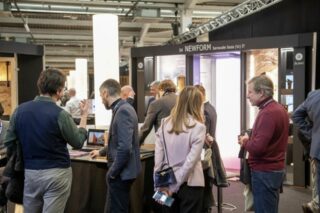Postwar Modernism in the United States was not a female-friendly movement. There was little room for women atop the pedestals in architecture, fine art, and industrial design. To be sure, in the art world there were prominent women artists practicing, but public acclaim was to come later; during the 1950s, they received little recognition from the sexist art critics who ruled the roost. In short, it was patriarchy. An exhibition at New York City’s Museum of Arts and Design examines the alternative mediums in which it was deemed acceptable for women to express themselves.
Pathmakers: Women in Art, Craft and Design, Midcentury and Today, starts at a time when there was a hierarchy of materials and methods and brings us to the present day where a measure of equality has been attained. It begins in the mid-20th century with a celebration of women who made objects from what were considered baser materials: textiles and ceramics.
“From a hierarchy of materials and methods to the present day where a measure of equality has been attained.”
The aesthetic impact of many of these early pathmakers was most profound in domestic environs. One was Edith Heath, who in the 1940s converted a sewing machine into a potter’s wheel upon which she crafted simple earthy bowls. By the 1950s, she had founded Heath Ceramics Sausalito, California and was mass-producing luxury tableware for stores throughout the United States.There also are a variety of pieces from the multifaceted Eva Zeisel who designed inexpensive mass-produced tableware for the Holl China Company. Included here are her metal-framed Resilient Chair, Clover Plexiglas Salad Bowel, and her Bellybutton Room Divider—all of which exhibit Zeisel’s playful sensibility and her interest in curved sensuous shapes.

Resilient Chair Frame, ca. 1948-1949 Eva Zeisel, designer
Courtesy of Jean Richards
The contemporary pathmakers in the exhibition tackle gender issues more overtly. Vivian Beer’s “Anchor Candy No.7” is a bench designed in the form of a glossy black stiletto shoe attached to a metal block. Another notable example is the work of Michelle Grabner who exhibits at New York City art galleries. On display here are her paper weavings based upon her son’s kindergarten art project and paintings that she made using crocheted baby blankets as stencils.In addition to exploring how women’s issues have become prominent subject matter in the visual arts, Pathmakers also documents the advances of women in fields and places that have traditionally been male-dominated. There are colorful fabric upholstered chairs and a reproduction of a hand-knotted curtain from Dutch designer Hella Jongerius’ 2004 redesign of the Delegate’s Lounge at the United Nations. From the world of industrial design, which is still dominated by men, there is an example of the elegant copper plumbing fixtures designed by the women-run Swedish firm, Front.
With more than 100 works by several dozen women artists and dating from the mid-century to the modern-day, it is a fool’s errand to draw generalizations about a “female aesthetic.” However, this show does show parallels between the emancipation of women artists from the midcentury Modernist patriarchy and the elevation of craftwork to the realm of fine art.

Two Sphere tables at the UN Delegates’ Lounge, 2013 by designer Hella Jongerius
Courtesy of JongeriusLab BV
Photo by Frank Oudeman












